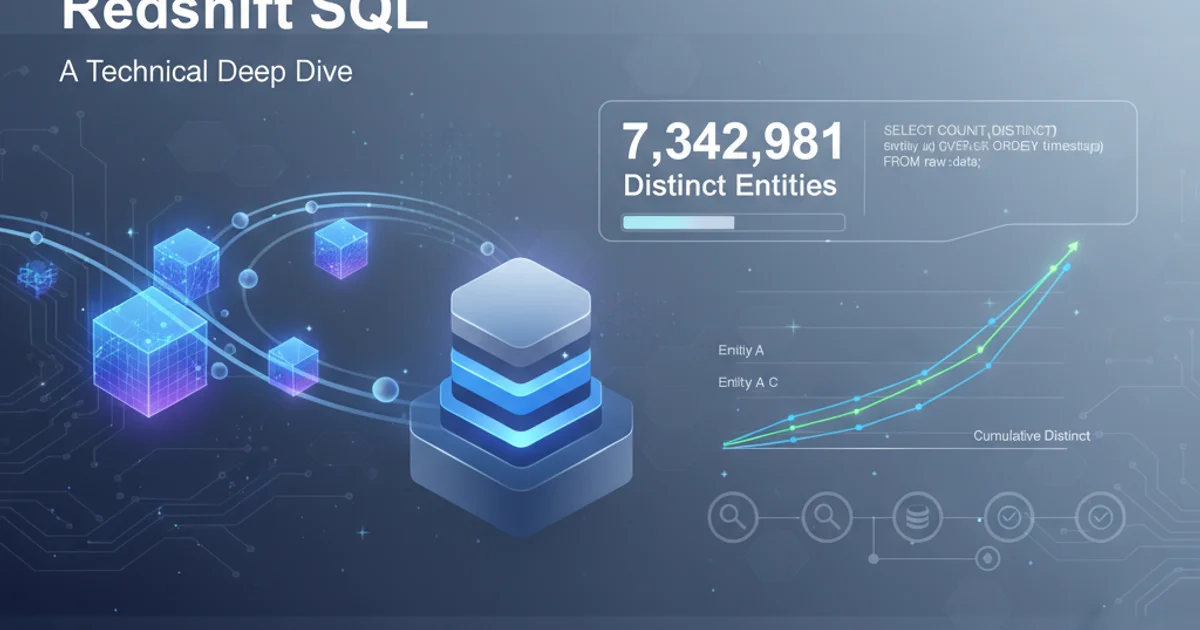Trying to count cumulative distinct entities using Redshift SQL
Counting Cumulative Distinct Entities in Redshift SQL

Learn how to efficiently calculate cumulative distinct counts in Amazon Redshift, addressing common challenges and exploring various SQL techniques.
Calculating cumulative distinct counts is a common requirement in data analysis, especially when tracking unique users, items, or events over time. In Amazon Redshift, this can be a performance-intensive operation due to the nature of distinct counts and window functions. This article explores effective SQL patterns and considerations for achieving accurate and performant cumulative distinct counts in your Redshift environment.
Understanding the Challenge of Cumulative Distinct Counts
The core challenge lies in the fact that COUNT(DISTINCT column) is not directly supported as a window function in Redshift (or most SQL databases) with an OVER (ORDER BY ...) clause. This means you cannot simply write COUNT(DISTINCT entity_id) OVER (ORDER BY date_column) to get a running distinct total. Each row's cumulative distinct count depends on all preceding rows, making it a complex aggregate that needs careful handling.
flowchart TD
A[Start] --> B{"Need Cumulative Distinct Count?"}
B -- Yes --> C{Redshift Limitation: No COUNT(DISTINCT) OVER (ORDER BY)}
C --> D[Consider Alternative Approaches]
D --> E[Approach 1: Self-Join with Subquery]
D --> F[Approach 2: Recursive CTE (Limited Use)]
D --> G[Approach 3: Array Aggregation (Memory Intensive)]
E --> H[Performance Considerations]
F --> H
G --> H
H --> I[Choose Best Approach for Data Size]
I --> J[End]Decision flow for cumulative distinct counts in Redshift.
Approach 1: Self-Join with Subquery (The Workhorse)
This is often the most practical and performant method for moderate to large datasets in Redshift. It involves joining the table to itself based on the date column and then performing a distinct count on the joined subset. While it might seem counter-intuitive, Redshift's query optimizer can often handle this pattern efficiently, especially with proper distribution keys.
SELECT
t1.event_date,
COUNT(DISTINCT t2.entity_id) AS cumulative_distinct_entities
FROM
your_table t1
JOIN
your_table t2 ON t2.event_date <= t1.event_date
GROUP BY
t1.event_date
ORDER BY
t1.event_date;
SQL query for cumulative distinct count using a self-join.
event_date column is part of your table's SORTKEY and DISTKEY if it's frequently used in joins and filters. This helps Redshift collocate data and speed up join operations.Approach 2: Array Aggregation (For Smaller Datasets)
For smaller datasets, or when you need to process the distinct values in a different way, you can use LISTAGG or ARRAY_AGG (if available in your Redshift version, though LISTAGG is more common for string aggregation) to collect all entity_ids up to a certain point, then process them. However, this method is highly memory-intensive and will likely fail or perform poorly on large datasets due to the size of the aggregated arrays/strings.
WITH daily_entities AS (
SELECT
event_date,
LISTAGG(entity_id, ',') WITHIN GROUP (ORDER BY event_date) OVER (ORDER BY event_date) AS cumulative_entities_str
FROM
your_table
GROUP BY
event_date
)
SELECT
event_date,
-- This part is tricky and often requires UDFs or client-side processing
-- to count distinct elements from a comma-separated string.
-- For demonstration, assume a UDF `count_distinct_from_string` exists.
-- COUNT_DISTINCT_FROM_STRING(cumulative_entities_str) AS cumulative_distinct_entities
LENGTH(REGEXP_REPLACE(cumulative_entities_str, '[^,]+', '')) + 1 AS estimated_count -- Very rough estimate, not distinct
FROM
daily_entities
ORDER BY
event_date;
Illustrative SQL for array aggregation (LISTAGG) - note limitations for distinct counting.
LISTAGG is generally NOT recommended for calculating cumulative distinct counts directly in Redshift due to its high memory consumption and the lack of a built-in function to count distinct elements from a delimited string efficiently. It's shown here for conceptual completeness but has severe practical limitations.Performance Considerations and Best Practices
When dealing with cumulative distinct counts in Redshift, performance is paramount. Here are some best practices:
- Distribution Keys: Choose an appropriate
DISTKEYfor your table. Ifentity_idis frequently used in joins or group-bys, it might be a good candidate. Ifevent_dateis the primary join key for time-series analysis, consider that. - Sort Keys: Define
SORTKEYonevent_dateto optimize range-restricted scans and joins, which are crucial for the self-join approach. - Materialized Views: For frequently accessed cumulative distinct counts, consider creating a materialized view. This pre-computes the results, significantly speeding up subsequent queries.
- Incremental Updates: If your data is append-only, explore strategies for incrementally updating your cumulative distinct counts rather than recomputing everything daily. This could involve storing the last known distinct set and only processing new data.
- Sampling/Approximation: If exact distinct counts are not strictly necessary, consider using approximate distinct count functions like
APPROXIMATE COUNT(DISTINCT column)if your Redshift version supports it (though this is typically for overall distinct counts, not cumulative). - ETL Process: Sometimes, the most efficient way to handle complex cumulative distinct counts is to pre-calculate them in your ETL process before loading data into Redshift, especially if the logic is very complex or resource-intensive.
1. Identify Key Columns
Determine the entity_id column you need to count distinctly and the event_date column for ordering the cumulative calculation.
2. Optimize Table Design
Ensure your table has appropriate DISTKEY and SORTKEY definitions, especially on the event_date column, to facilitate efficient self-joins.
3. Implement Self-Join Query
Use the self-join pattern provided in Approach 1. Test it with a representative subset of your data to gauge performance.
4. Monitor Performance
Use Redshift's query monitoring tools (e.g., SVL_QUERY_SUMMARY, STL_QUERY) to analyze query execution plans and identify bottlenecks.
5. Consider Materialized Views
If the query is run frequently and the underlying data changes predictably, create a materialized view to pre-compute and store the results.